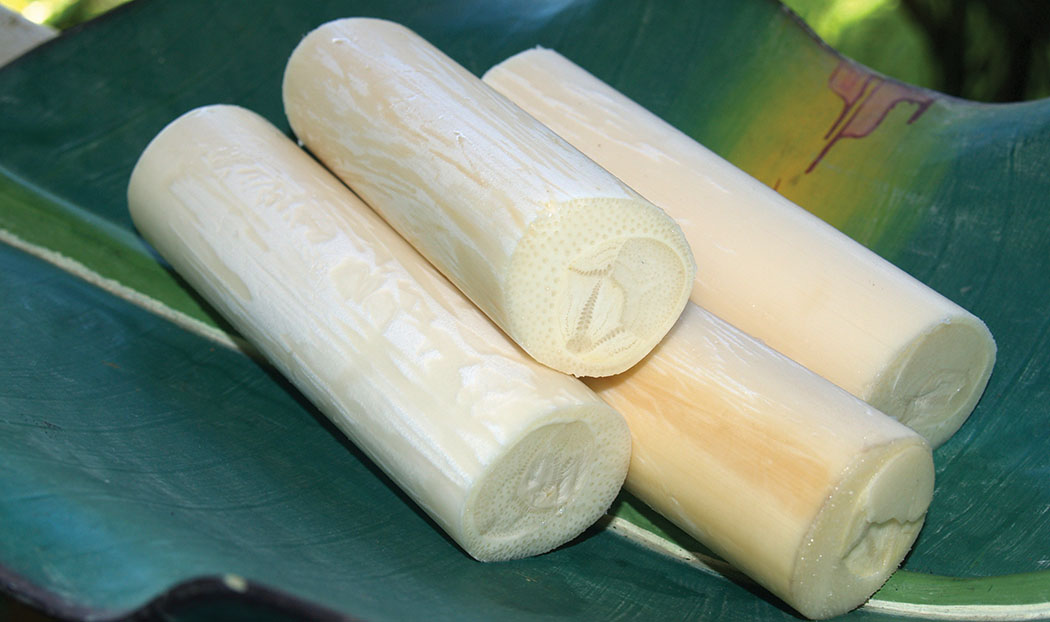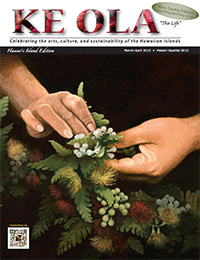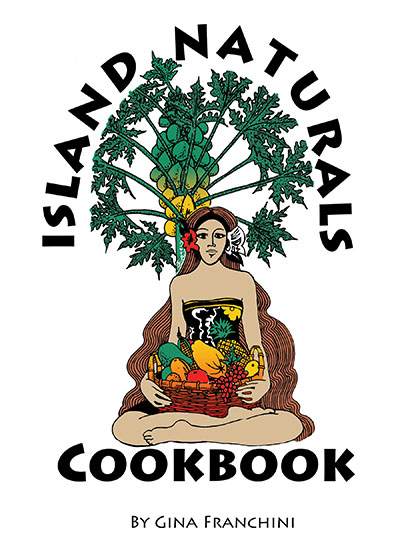
Heart of Palm
 By Sonia R. Martinez
By Sonia R. Martinez
One item often missing in most farmers’ markets is the heart of palm, so when you find it, it’s like striking gold.
You can harvest heart of palm from any kind of palm tree, including the coconut. The quality varies depending on the type palm tree itself.
In many countries where the palms are cultivated for the heart, the trees used mostly in commercial plantings are Bactris sps. Another is Euterpe oleracea, also known as acai palm but that is now harvested mostly for the fruit. Some of the palms are still harvested from the wild and are therefore not sustainable.

In Hawai‘i, the palm of choice is the spineless pejibaye or peach palm (Bactris gasipaes), a multi-stemmed variety that can be harvested moderately without killing the entire plant, making it a renewable and sustainable resource.
The parts of the palm that are cut at the time of harvesting, such as the fronds and outer layers of the tree are usually recycled as compost, thus enriching the soil and controlling weeds. They also serve as protection for the new shoots that sprout around the mother plant.
In 1990, the peach palm was first introduced experimentally as a commercial product in Hawai‘i, and originally there were just a couple of farms growing them. The first harvests of hearts of palm were shared directly with several chefs on the island who were very excited to have the fresh product available and proceeded to feature this exotic product in their menus. Since then, several other farms have joined in and the fresh hearts of palms have become more familiar to the public via several food expositions around the islands and through a few selected farmers’ markets.
This choice ‘gourmet’ delicacy is found encased in a tough cylindrical husk. Peel the husk until you reach the tender, delicate flavored, crispy, and creamy ivory flesh. Hearts of palm are an excellent source of protein, potassium, riboflavin, calcium, iron, Vitamin C, and fiber while low in calories, sodium, and cholesterol. I find the taste slightly sweet. Many people compare it to an artichoke in flavor, although the appearance is more like a thick and firm white asparagus.
Depending on the recipe, heart of palm can be eaten raw, steamed, grilled, roasted, or boiled. An excellent addition to salads, casseroles, stews soups and chowders, grain and pasta dishes, as well as quiches; it can give a nice crunch to fresh salsas and can be used to make delicious pickles.
I chose to use it in a very simple, fresh and delicious salad combined with crab claw meat. Any other shellfish such as lobster or shrimp would pair well.
The following was made recently to share at a gathering of friends and there was not one scrap left.
Baby Spinach, Heart of Palm and Crab Salad
Large bundle of fresh baby spinach
1 piece raw heart of palm, 1-1/2 foot long cylinder
12 ounces crab claw meat, picked clean of shells
Wash the spinach in cold water and let it sit a few minutes in the cold water to crisp a bit, then drain and pat dry.
Cover the bottom of a bowl or serving platter with the spinach. Cut the heart of palm into round slices and take apart in ‘rings’. Sprinkle the crab meat on top.
Serve the dressing on the side. I chose to make citrus vinaigrette for our dressing.
Citrus Vinaigrette

1/2 Cup orange juice 1/2 Cup lemon juice – I used Meyer
2 Tablespoons garlic infused extra virgin olive oil
2 Tablespoons honey
1 Tablespoon prepared mustard
1 Tablespoon light soy sauce
1 rounded Teaspoon ground cumin
2 full Tablespoons grated ginger
Place all ingredients in blender and mix well. Pour into a lidded glass jar or cruet and store in refrigerator.
Photos by Sonia R. Martinez
Contact writer Sonia R. Martinez: SoniaTastesHawaii.com


